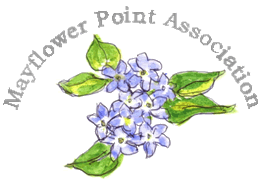More Native Flowers and Ground Covers (from our archive)
August 2024: Purple lovegrass, Eragrostis spectabilis.
 Sometimes a native plant has such a wonderful name that you can't help but be intrigued. Such is the case with purple lovegrass.
Sometimes a native plant has such a wonderful name that you can't help but be intrigued. Such is the case with purple lovegrass.
Who cannot love a grass whose seeds, and the stalks bearing them, are tinged with purple at the height of summer, giving the entire mound a hazy pink glow? As summer gives way to fall, the pink fades to shades of blush and beige, and the finely textured stalks capture morning dew. As the Latin name also suggests, this grass is spectacular.
The geographic range of purple lovegrass is impressive, too. It can be found in the wild in just about every US state east of the Continental Divide (skipping just Montana), and also in Arizona.
 Purple lovegrass thrives in full sun in sandy soil, as the photo at left, taken on the Salt Pond trail in Eastham, demonstrates. It shrugs off the hot, dry spells of peak summer that make many other plants wilt. In moister and more fertile soils, in fact, it will be outcompeted by taller perennials.
Purple lovegrass thrives in full sun in sandy soil, as the photo at left, taken on the Salt Pond trail in Eastham, demonstrates. It shrugs off the hot, dry spells of peak summer that make many other plants wilt. In moister and more fertile soils, in fact, it will be outcompeted by taller perennials.
For all its toughness, purple lovegrass is delicate in appearance. It makes a neat mound about 12 inches high excluding the seed stalks, which may reach another foot in height, and the seeds create a scrim-like effect before and between taller plants. To ensure it pops in a garden bed, purple lovegrass should be planted in small groups.
For those of us with “Cape Cod lawns,” purple lovegrass may be a solution if planted on a larger scale. The North Carolina extension service says purple lovegrass “can be mowed a few times a year if it is being used as a lawn alternative that is exposed to light foot traffic.”
What’s not to love?
May 2024: Sundial lupine, Lupinus perennis.
“I think it pisses God off if you walk by the color purple in a field somewhere and don't notice it.” The character who ventures this opinion in Alice Walker's The Color Purple might be imagining sundial lupine in bloom.
 In spring, this perennial produces magnificent lavender and purple flowers not only in New England, but southwards along the Atlantic coast to northern Florida and then west to Louisiana.
In spring, this perennial produces magnificent lavender and purple flowers not only in New England, but southwards along the Atlantic coast to northern Florida and then west to Louisiana.
Like many plants indigenous to Cape Cod, lupines like sandy soil and thrive in it because they fix their own nitrogen from the air. Sundial lupine’s blossoms mature into seedpods that split open to provide food for birds and small mammals (but which are toxic to humans). Butterflies, bees and hummingbirds feed on its nectar.
Sundial lupine hosts the caterpillars of several moth and butterfly species and is the sole host for the Karner Blue butterfly, which is threatened with extinction as this wildflower’s native habitat is developed and naturally occurring fires are suppressed. An additional threat is the introduction to New England of lupinus polyphyllus, a native of the western United States that is out-competing its local cousin, especially in Maine.
Therefore, if you are tempted to cultivate lupines for your Cape Cod garden, make sure you get lupinus perennis. You can mow the plants each fall to score the seeds’ hard shells and promote germination.
March 2024: Moss
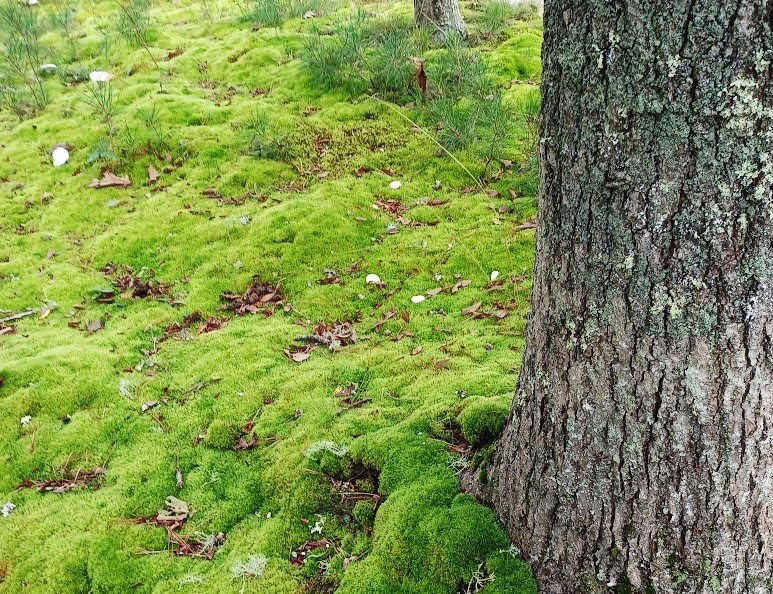 When we think of plants, we most likely picture those with trunks or stems attached to roots. Indeed, a dazzling array of species fall into the several divisions of vascular plants in the Plant Kingdom under the Linnean classification system. But one division—Bryophyta—is reserved just for the world’s more than 12,000 species of mosses, which absorb moisture directly through their leaf cells and therefore stay low to the ground or other moist surfaces.
When we think of plants, we most likely picture those with trunks or stems attached to roots. Indeed, a dazzling array of species fall into the several divisions of vascular plants in the Plant Kingdom under the Linnean classification system. But one division—Bryophyta—is reserved just for the world’s more than 12,000 species of mosses, which absorb moisture directly through their leaf cells and therefore stay low to the ground or other moist surfaces.
In New England, mosses perform important ecological functions. As anyone who has seen moss growing on rock can appreciate, mosses are pioneers of barren terrain. The New York Botanical Garden notes that mosses can combine with lichen to stabilize sand dunes and provide the necessary conditions for successive vegetation.
Moreover, mosses act as sponges, retaining many times their own weight in water and then releasing it slowly, helping to curtail flooding and runoff in wet periods, and providing moisture in drier spells. While mosses prefer moist, shaded conditions, they can go dormant during droughts, and swell into green color once rain returns.
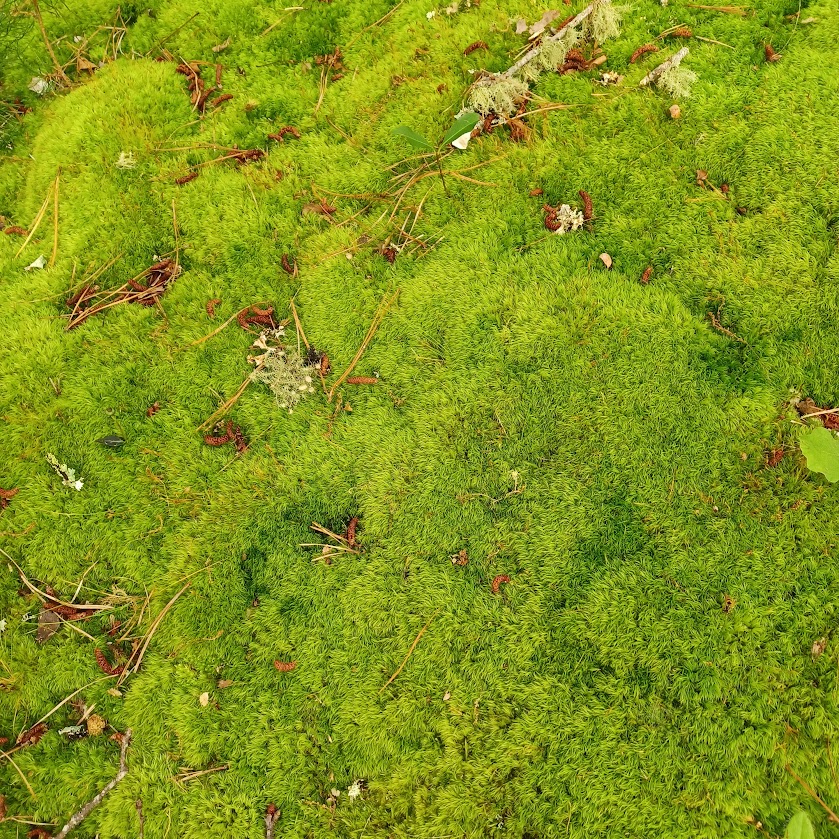 A carpet of moss has a timeless, primeval quality, as if we sense that mosses were on the earth tens of millions of years before the first mammals and flowering plants appeared.
A carpet of moss has a timeless, primeval quality, as if we sense that mosses were on the earth tens of millions of years before the first mammals and flowering plants appeared.
In Japan, a proper reverence for moss is a requirement for entering Koke-dera, the famed “Moss Temple.” Arriving visitors must kneel at a low desk to copy the brushstrokes of a Buddhist sutra with a quill pen as monks chant; only then do they gain admittance to the temple’s velvety, mysterious, moss-covered grounds.
Luckily, as these photos show, we can find our own mossy worlds here on Mayflower Point with a casual walk; reverence is optional but encouraged.
October 2023: New England aster, Symphyotrichum novo-angliae.
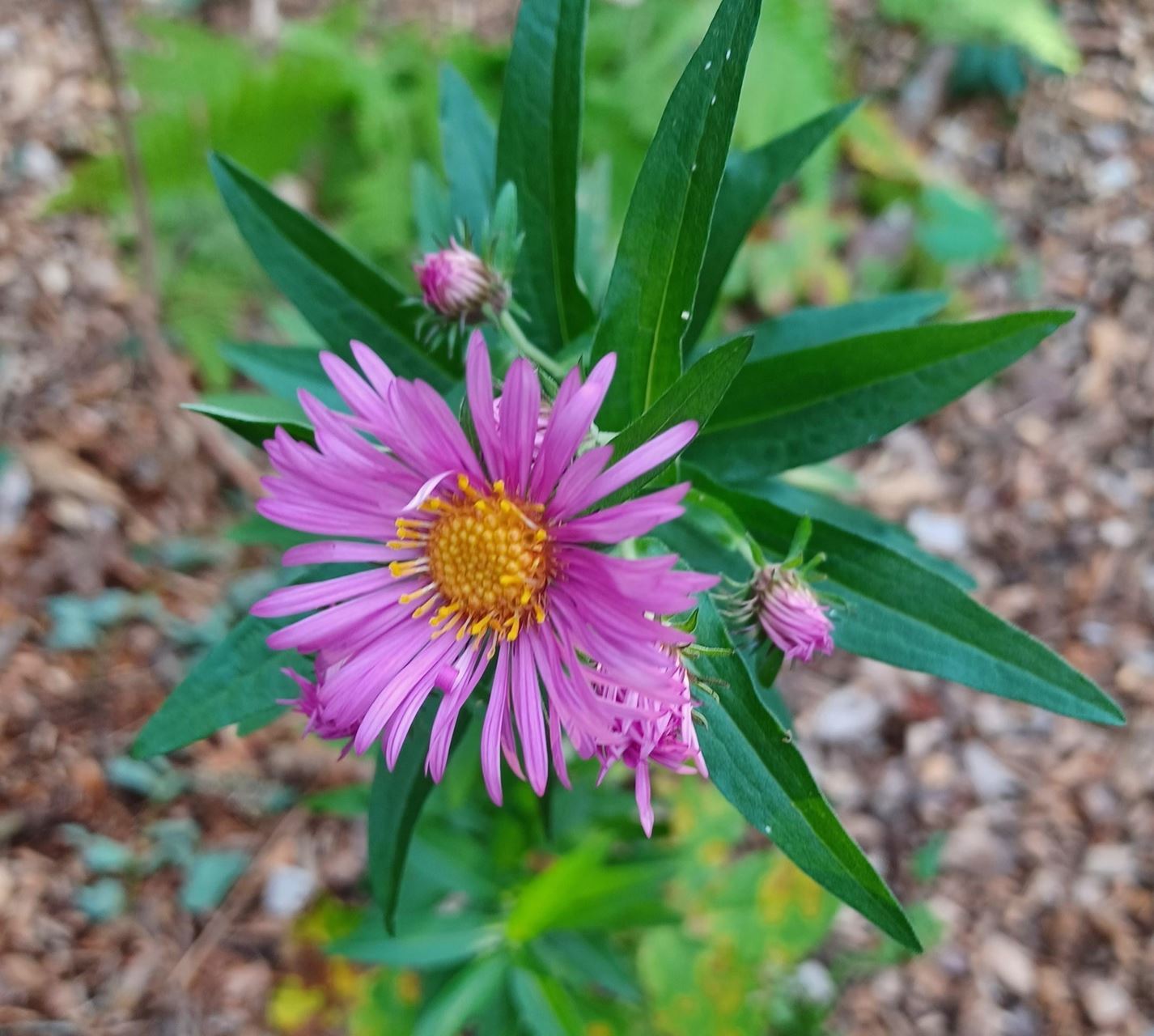 New
England aster ranges far beyond the region of its name: it is native to
a broad swath of the United States sweeping west from the northeast and
mid-Atlantic states to the eastern edges of Montana, Wyoming and
Colorado and even to pockets in New Mexico.
New
England aster ranges far beyond the region of its name: it is native to
a broad swath of the United States sweeping west from the northeast and
mid-Atlantic states to the eastern edges of Montana, Wyoming and
Colorado and even to pockets in New Mexico.
Its rich purple color, a vibrant complement to goldenrod, which also blooms in the fall, captures our attention in meadows, roadside verges and cultivated gardens.
New England aster prefers relatively sunny locations that retain some moisture. When these conditions are met, it can grow as tall as six feet. If that is too obstreperous for your garden, you can cut the plant back by half on Memorial Day and then again, if you’re so inclined, on July 4, to produce a bushier plant.

But you might want to go easy: the pearl crescent, a pretty orange butterfly with black edges on its wings, lays its eggs on the undersides of the leaves from spring through fall. Once New England aster flowers, its nectar attracts many other pollinators, including bees and the monarch butterfly.
Four other asters in the Symphyotrichum genus are native to Cape Cod and also beloved by pollinators: S. cordifolium (blue wood aster), S. laeve (smooth aster), S. novo-belgiae (New York aster) and S. puniceum (purple-stemmed aster). They, too, bloom in autumn but generally in paler tones of lavender and blue.
September 2023: Goldenrod, Solidago.
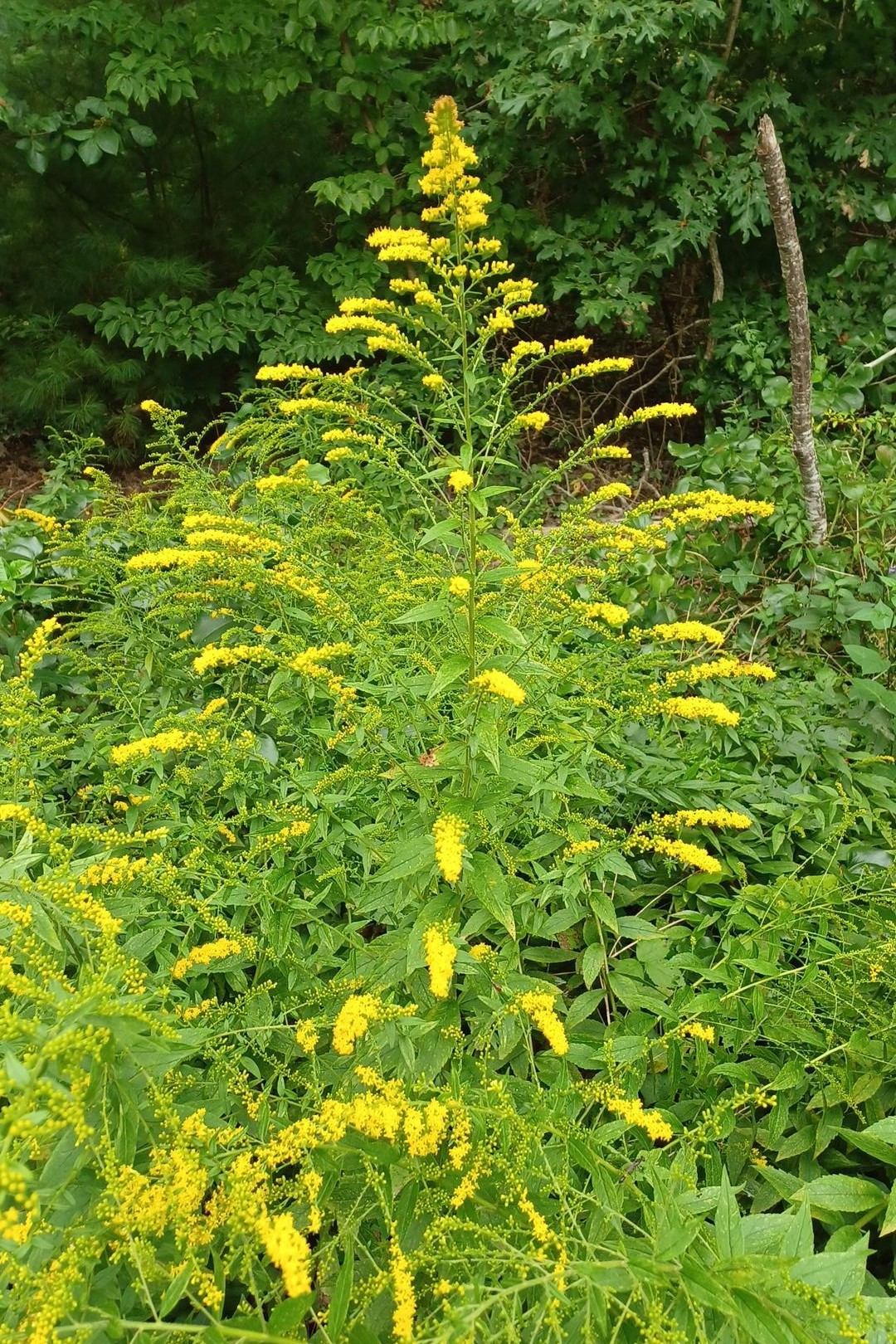 This
month, our fields and roadsides take on a golden tinge, thanks to the
blossoms of the many goldenrod species that thrive on Cape Cod. While some species can tolerate more shade than others, most revel in bright sun.
This
month, our fields and roadsides take on a golden tinge, thanks to the
blossoms of the many goldenrod species that thrive on Cape Cod. While some species can tolerate more shade than others, most revel in bright sun.
What all these goldenrod species have in common is their status as “pollinator powerhouse plants,” the designation the Native Plant Trust gives native plants that “support a proportionally large number of caterpillar species.” For herbaceous plants like goldenrod, the label means that they host caterpillars of more than 15 insect species. (Caterpillars, in turn, often serve as food for birds and their young.) Adult bees, butterflies and moths also visit goldenrod blossoms for nectar.
Goldenrod’s reputation has suffered in the past because it blooms at the same time as ragweed, the bane of allergy sufferers. However, whereas ragweed pollen is dispersed by the wind, which is how it ends up in human nostrils, goldenrod’s sticky pollen requires bees and other pollinators for dispersal.
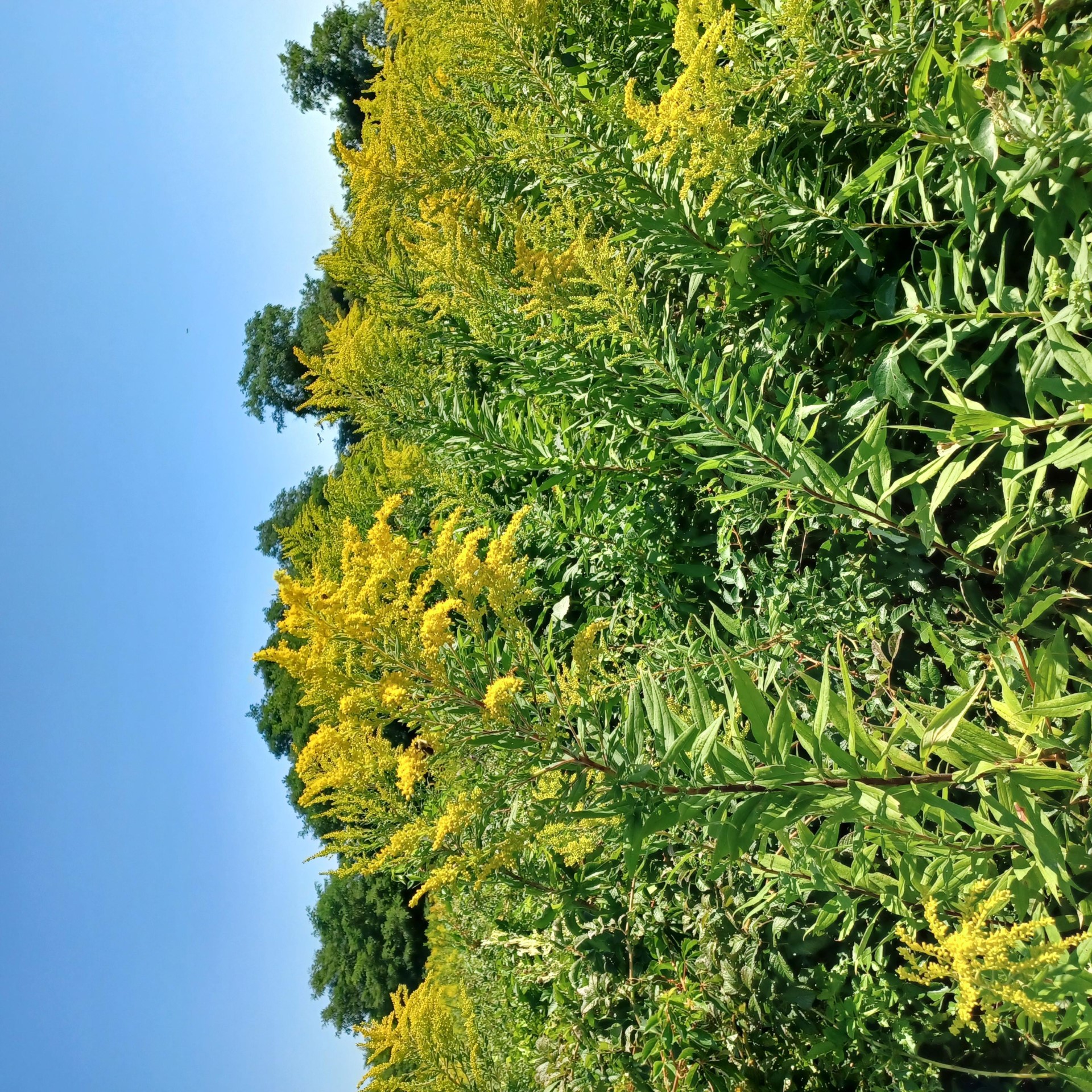
Goldenrod is sometimes considered weedy because it can opportunistically take advantage of disturbed soil to take root, but its exuberance is much more restrained in stable areas.
Nonetheless, a strong argument can be made for exuberance, as demonstrated by this field of goldenrod at Fort Hill.
April 2023: Mayflower (aka trailing arbutus), Epigaea repens.
|
Previous generations of New Englanders, including poets Emily Dickinson and John Greenleaf Whitter, cherished the mayflower as one of the first wildflowers to bloom in spring. Nowadays, when we stud our gardens with (non-native) daffodils and forsythia for early spring color, it’s easy to overlook the subtle charms of this diminutive plant. As Dickinson observed, it is “covert in April / candid in May….” Whittier imagined the Pilgrims’ joy as they “saw the blossoms peer / Above the brown leaves….” Although we have no documentation of how the Pilgrims regarded this North American species, it would have been novel to them. (Their ship was named after the May-flowering English hawthorn.) |
Mayflower in its covert phase |
|
Epigaea repens has been the Massachusetts state flower since 1918 and protected as an endangered species since 1925. Mayflower is native throughout most of the United States east of the Mississippi River, but it is always rare. It is sensitive to logging, grazing and other disturbances and almost impossible to transplant and cultivate. Indeed, the Virginia Native Wildflower Society cautions against purchasing trailing arbutus from a nursery, “because in all likelihood plants for sale are from the wild and will perish in any event.” What
mayflower likes best is undisturbed ground under an open pine canopy
where it will not be smothered by fallen leaves. If you find mayflower
as you walk in the woods, regard it reverently and let it be. |
Mayflower in its candid phase |
March 2023: Bearberry, Arctostaphylos uva-ursi.
 This
evergreen native ground cover, no more than a foot tall, thrives in the
harsh conditions found in arctic regions, windswept coasts and alpine
environments. It produces white and pink blossoms in spring that mature
into red berries, and its green leaves turn reddish bronze in the
fall. As its common and Latin names imply, bears love to eat its
berries, but smaller mammals, as well as birds, find them tasty, too.
You can find it growing in the wild on the Marconi site in Wellfleet and
on the Bearberry Hill trail in Truro.
This
evergreen native ground cover, no more than a foot tall, thrives in the
harsh conditions found in arctic regions, windswept coasts and alpine
environments. It produces white and pink blossoms in spring that mature
into red berries, and its green leaves turn reddish bronze in the
fall. As its common and Latin names imply, bears love to eat its
berries, but smaller mammals, as well as birds, find them tasty, too.
You can find it growing in the wild on the Marconi site in Wellfleet and
on the Bearberry Hill trail in Truro.
Bearberry is happiest in full sunlight and out from under trees. In the right conditions, it will spread by runners to cover several square feet. William Cullina, in his guide to Native Trees, Shrubs and Vines, calls bearberry “one of our finest groundcovers” but highlights its “intolerance for all but poor, acid sand.” However, for Cape Cod gardeners, this is a feature, not a bug. As the Native Plant Trust advises, “This plant thrives on neglect.”
March Activity: If you are tempted to reduce some of your lawn to provide more room for native plantings, an easy way to get started is to lay cardboard or thick layers of newspaper on the area you’d like to convert. Wet the cardboard or newspaper down and then cover it with a few inches of leaf or bark mulch. After several weeks, it will be relatively easy to dig through the sodden cardboard and decomposing grass to plant the native perennials, shrubs or groundcovers that have piqued your interest.
